A beggar’s genuine existence consists of multiple complex layers which include societal as well as economic factors alongside mental health aspects and medical needs. This narrative follows the path of difficulty during survival and features societal disregard towards these individuals. The article analyzes the authentic lives of street beggars through both statistical information and candid testimonies to outline their genuine situations.
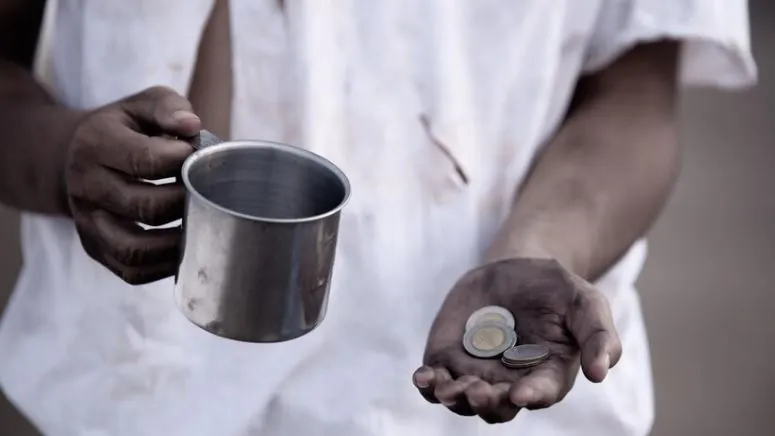
👉You should share your remaining bread with someone seeking help while showing them deep appreciation for letting you participate in his starvation. The act of giving needs humble presentation and you should express gratitude to him for permitting your participation in his need👈
👉The Reality of Begging: More Than Just a Handout :-
People typically view begging as an easy street activity of requesting money or food from others. The genuine life of people who beg shows a complex pattern which includes living in poverty and experiencing homelessness along with social isolation and health struggles and possible mistreatment by others.
👉Causes of Begging and Homelessness :-
People from various walks of life become beggars because of shared elements that make them susceptible to this condition:
⏩Loss of Employment & Economic Hardship :- Economic difficulties alongside employment termination drives several individuals into begging because of health problems or aging factors or shifts in the economy. A research study on elderly beggars revealed employment loss as a primary factor which led them to start begging because they struggled to obtain new work because of health problems along with aging issues.
⏩ Breakdown of Family Life :- Family life breakdowns from family conflicts or divorce or abandonment act as leading factors that push people toward begging. The breakdown of marriages among elderly individuals became the initial factor that led them into homelessness and begging according to half of the participants in a study.
⏩Loss of Loved Ones :- When family members die and leave a person without support the individual may resort to begging as a means of survival.
⏩Substance Abuse :- The addiction to alcohol or drugs creates a cycle of dependency and poverty because it worsens or initiates the condition of beggars which traps them in this pattern.
⏩Natural Disaster & Displacement :- Natural disasters coupled with displacement events such as floods and earthquakes create circumstances which drive people to begging for basic survival needs after they lose their homes. Additionally, rural area caste-based discrimination forces displacement.
⏩Unaffordable Housing :- The combination of expensive housing and rental impossibility leads to homelessness that drives individuals into begging so they can afford their necessities.
👉Scale and Demographics of Begging and Homelessness :-
Begging occurs as a surface-level manifestation of homelessness and poverty throughout the world and within national territories.
⇒Research conducted in 2023 showed that homelessness affected 650,000 people in the United States on one night with a notable 12% rise from previous year statistics. About 40% of homeless individuals reside without shelter by sleeping outdoors and in vacant structures and through homelessness.
⇒Regular begging exists in India with about 400,000 known individuals who beg as a profession but West Bengal and Uttar Pradesh report the most cases. The practice of begging in India emerges from three main factors: poverty, disabilities and displacement alongside the activity of professional begging rings.
⇒The employment prospects of beggars suffer because of chronic health issues like leprosy and disabilities that prevent them from working even though they also face social discrimination.
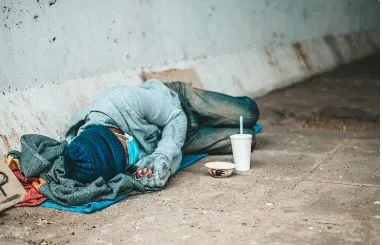
👉Daily Life and Struggles of Beggars :-
Beggars face three major challenges in their everyday existence which include unknown circumstances alongside physical challenges alongside societal discrimination.
⏩Survival on the Streets :- Beggars must spend numerous hours walking while begging at public settings including marketplaces bus stops and religious sites. Beggars struggle to make enough money to buy food shelter and healthcare because their earnings remain unstable and unstable.
⏩Health Challenges :- Many individuals who beg suffer from medical problems as well as unattended wounds because they lack access to proper medical care. Child beggars in Georgia show bleeding feet because they must go without bathing facilities combined with inadequate footwear.
⏩Social Stigma and Isolation :- Beggars face discrimination, exclusion, and sometimes violence from society. The social discrimination that they experience makes their feelings of helplessness and isolation worse.
⏩Psychological Burden :- People who beg experience psychological stress and invisible feelings while dealing with depression and heavy mental burdens. Beggars from both young and old demographics frequently experience emotional distress because of problems within their families together with abuse and the loss of loved ones.
👉Stories of Hope and Transformation :-
Individual beggars have managed to change their circumstances through perseverance combined with available opportunities together with unexpected acts of generosity.
⏩Jose Antonio from Spain :- He held a profession as electrician until he lost his home due to unfortunate events in his life. A barber’s free makeover transformed the person into a viral sensation that opened doors to modeling work and job employment thus demonstrating how dignity and hope can revive.
⏩Donut King, Ted :- He fled Cambodia during wartime to establish an American doughnut business which collapsed because of addiction before he lived as a panhandler on the streets. This tale warns people about the risks of excessive ambition along with the unstable nature of wealth and extravagant spending.
⏩Cory, Former Investment Banker :- Following the 2008 financial crisis Cory who used to work as an investment banker experienced total financial ruin before becoming a beggar. The man established his business dominion as he continued dwelling outdoors and thus contradicted standard beliefs about financial accomplishment.
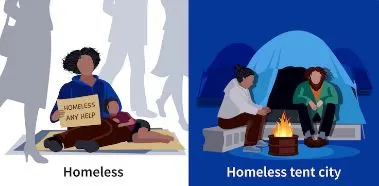
👉The Role of Organized Begging and Exploitation :-
Organized begging exists as a group survival method in multiple areas.
⇒Begging in India now operates as a complex socio-economic problem where syndicates profit from controlling vulnerable populations which includes disabled persons and children.
⇒These cartels manage begging territories while abusing children to work as beggars and they drug or abuse their victims to gain more money through sympathy.
👉Government and Social Responses :-
The combination of shelters with healthcare services along with financial access and social assistance programs forms the basis for addressing street begging and homelessness.
⇒The U.S. homelessness response systems grew their shelter and housing network while the shortage of affordable housing continues to reduce their impact.
⇒The ability to participate in financial systems proves essential because many beggars do not know how to use banks which bars them from accessing official support and government services.
⇒Community organizations together with NGOs deliver food and healthcare and educational programs and rehabilitation services to beggars especially children.
⇒The implementation of both legal and social approaches to break down begging rings faces difficulties while simultaneously working to protect defenseless populations.
In Conclusion, Beggars experience a real life narrative which combines hardship with survival challenges along with occasional opportunities for redemption. The conditions that form a person’s life as a beggar result from economic difficulties combined with social barriers and health problems and institutional breakdowns. Real data about the life of beggars together with personal stories demonstrate the acute necessity for solutions that will give back dignity and opportunities to the people who are forced to beg. Society needs to resolve poverty and homelessness and exploitation at their sources because these conditions determine the fate of beggars around the globe.
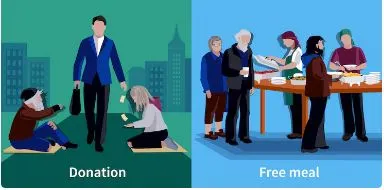
👉Main Reason Why People become Homeless for the First Time :-
Systemic economic and social factors create the main causes that make people become homeless for the first time instead of individual circumstances. Key causes include:
1. Lack of Affordable Housing :-
Severe housing affordability shortages serve as a main factor that leads people to experience homelessness for the first time. The price of rental housing across the United States grew much faster than worker wages especially for people earning minimum wages. Full-time workers must earn $25.82 each hour to pay for a two-bedroom rental unit because the federal minimum wage stays at $7.25 per hour. Stable housing remains unreachable to many people because they cannot afford the market rates thus leading them to possible eviction and eventual homelessness.
2. Insufficient Income and Economic Hardship :-
Public benefits together with stagnant wages cannot match the increasing expenses that people face in their daily lives for housing, food and healthcare. Low-income individuals along with families typically allocate more than fifty percent of their income towards rent expenses thus having minimal funds for basic necessities. People lose their homes and become homeless in a short period after they either lose their jobs or experience employment instability because they lack funds to pay rent and develop savings.
3. Health Issues and Medical Costs :-
People face financial problems when they become disabled or develop chronic health issues or experience unexpected medical situations because they lose their income and need to pay steep medical expenses. People without affordable health care or insurance will exhaust their savings and potentially lose their employment so they cannot maintain housing. The combination of untreated health conditions leads many people toward becoming homeless.
4. Family Conflict and Domestic Violence :-
Family disagreements that lead to domestic violence create one of the primary reasons why people become homeless. No available alternative housing options compels victims of abusive relationships to become homeless. Family rejection creates extreme hardships for LGBTQ+ youth because approximately 1.6 million young LGBTQ+ people face annual homelessness due to their families rejecting or conflicting with them.
5. Loss of Social Support Networks (Relational Poverty) :-
The breakdown of social networks which should normally provide assistance or temporary shelter causes numerous individuals to become homeless. The sense of isolation known as relational poverty creates deep loneliness and increased vulnerability while making it more difficult for people to prevent or escape becoming homeless.
6. Mental Illness and Substance Use :-
Mental health conditions alongside addiction tend to make homelessness worse but they do not create homelessness as the primary cause. Severe mental illnesses affect 16% of single adults who are homeless and substance dependency is a widespread condition among this population. People typically develop addictions after their homelessness starts since addiction serves as their way to cope.
7. Systemic Racism and Marginalization :-
Racial and ethnic minorities along with LGBTQ+ individuals and Indigenous and People of Color face increased barriers to access basic necessities because they experience discrimination in shelter, work and societal support systems. Systemic inequality as a result of discrimination places these people at higher risk of becoming homeless.
8. Natural Disasters and Economic Shocks :-
Sudden natural disasters together with economic downturns lead to house destruction and job termination which forces people into immediate homelessness. When such unexpected events strike it surpasses the available financial and social protection systems of affected people.
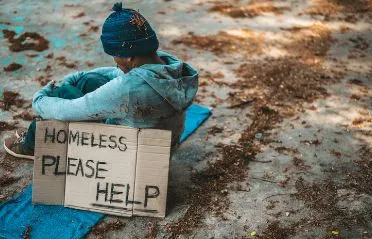
👉What Challenges did Beggar Face in his Journey :-
This analysis draws from actual reports of beggars alongside literary information and scholarly research to present their difficulties.
1. Loss of Livelihood and Economic Collapse :-
⏩Job Loss :- Many beggars, especially the elderly, lose employment due to age, health issues, or economic downturns. Homeless beggars identified job loss as their main reason for entering homelessness in the studied population which prevented them from securing both housing and food.
⏩Poverty :- The lack of financial reserves and social security programs drives people into becoming beggars because of persistent poverty. Families become homeless mainly because they face agricultural failures, earn low wages and suffer from increasing debt.
2. Health Crises and Disabilities :-
⏩Untreated Illness :- Beggars endure untreated health conditions because they lack medical care for their leprosy as well as vision impairment and substance abuse-related health problems. The emotional toll of vision loss, for instance, exacerbates feelings of helplessness and isolation.
⏩Addiction :- Substance abuse, often a coping mechanism, traps individuals in a cycle of dependency. Drug abuse together with alcohol addiction leads to poorer physical condition and social discrimination against affected individuals.
3. Family Breakdown and Social Isolation :-
⏩Nuclear Family Rejection :- The rejection of elderly beggars often occurs when their children decide to migrate or choose not to provide any care. According to one participant they were forced to stay in an old-age facility before taking up begging.
⏩Loss of Loved Ones :- Emotional devastation from losing loved ones together with financial instability follows when family members pass away. A person who begged in the study became homeless after his family died in a tragic accident which triggered him to start using drugs.
4. Systemic Inequality and Discrimination :-
⏩Caste & Class Barriers :- The practice of caste discrimination along with class systems in certain areas pushes marginalized communities into homelessness and unemployment which leads them to beg. The respondent described caste prejudice as the cause of his homelessness after surviving a natural disaster.
⏩Lack of Affordable Housing :- The affordability of housing continues to deteriorate so low-income people become uniquely vulnerable to rental price increases and forced eviction. One beggar became homeless after losing his job combined with exhaustion of his financial savings.
5. Psychological and Emotional Struggles :-
⏩Existential Despair :- The main character in Mahfouz’s The Beggar develops existential despair because he faces identity crises and becomes hopeless. Through his suffering Omar al-Hamzawi exhibits the wider mental distress that comes from feeling split and empty of direction.
⏩Stigma & Shame :- Beggars face societal contempt, which erodes self-worth. Visually impaired beggars experience ongoing humiliation together with a continuous battle to maintain their dignity throughout their emotional path.
6. Exploitation and Organized Crime :-
⏩Begging Syndicates :- Beggars sometimes operate under syndicates that profit from their earnings by taking a share of their collected funds. Trafficking rings force vulnerable children and adults into street begging activities since they lack their own options for survival.
⏩Survival Tactics :- Lushkoff from Chekhov’s The Beggar practices deception to gain sympathy from others with deceptive methods yet this behavior leads to both mistrust and continued dependency patterns.
7. Natural Disasters and Environmental Hardships :-
⏩Displacement :- Floods together with droughts and earthquakes drive numerous households to lose their residences and sources of survival. A man who lost his family during a disaster mentioned experiencing discrimination based on his caste when looking for a place to stay.
⏩Exposure to Elements :- The lack of shelter forces homeless beggars to face severe weather conditions which results in persistent health problems.
8. Moral and Ethical Dilemmas :-
⏩Public Perception :- Beggars need to manage their feelings of debt toward charity while simultaneously coping with negative public attitudes toward them. Even when people provide assistance to beggars they remain objects of pity or uncertain regard according to “The Beggar’s Hunt.”
⏩Loss of Autonomy :- The need to depend on others robs homeless persons of their independence and intensifies their feelings of becoming invisible and unworthy.
The beggar’s path shows multiple crises which combine economic breakdown with poor health and social rejection and psychological breakdown. The stories of Lushkoff from Chekhov and present-day Indian elderly beggars demonstrate shared elements that include exposure and strength alongside institutional disregard. The transformation of these issues needs complete solutions which include cost-effective housing and medical care along with drug rehabilitation services and social support to rebuild self-esteem and independence.
👉Conclusion :-
Beggars experience a real life narrative which combines hardship with survival challenges along with occasional opportunities for redemption. The conditions that form a person’s life as a beggar result from economic difficulties combined with social barriers and health problems and institutional breakdowns. Real data about the life of beggars together with personal stories demonstrate the acute necessity for solutions that will give back dignity and opportunities to the people who are forced to beg. Society needs to resolve poverty and homelessness and exploitation at their sources because these conditions determine the fate of beggars around the globe.
https://vocal.media/fiction/a-beggar-s-life-a-heart-touching-journey
💬Disclaimer :-
This Blog provides general information as an educational source only. The author uses their life experiences together with personal viewpoints to create all content. The author accepts no responsibility for damages or losses when users apply this information. The website information depends on your individual acceptance of personal risk when you use it. The information does not serve as professional guidance, so readers need to seek proper professional advice before implementing decisions from the provided content.